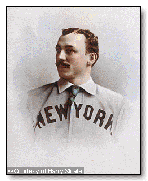
In 20 major league seasons he hit nearly .300, and he ranks high in such lifetime statistics as hits, runs, and RBIs. Davis was a World Series hero in one of the Fall Classic's greatest upsets, yet he only last year was inducted into the Baseball Hall of Fame.
Davis began his career in 1889 with an independent minor league team in Albany, New York. Although no records survive, he apparently performed well enough to be brought up to the National League in 1890 by Cleveland. In his first two seasons he was primarily an outfielder, but in his third year he moved to third base. Although his batting marks of .264, .289, and .241 were unremarkable, he hit with power, averaging 102 runs scored and 81 RBIs a season. In 1893 he was traded to the New York Giants for Buck Ewing, who was considered one of the great players of the age.
The arrival of the 5-foot-9, 180-pound Davis in New York coincided with an increase in the pitching distance from 50 feet to 60 feet 6 inches. As a result, Davis's average jumped more than 100 points to .355. He played with the Giants for nine seasons, hitting more than .300 each year. In each of four seasons he scored more than 100 runs and in three seasons collected more than 100 RBIs.
Davis's best year offensively was 1897, when he batted .353, stole 65 bases, scored 112 runs, hit 31 doubles, 10 triples, and 10 home runs, and led the league with 136 RBIs. He also became New York's regular shortstop after several years of utility play. Two years later he led all NL shortstops in fielding, a feat he repeated in 1900.
Despite Davis's outstanding play and the efforts of a few teammates, the 1890s Giants represented a low point in the club's history between the pennant-winning clubs of the 1880s and John McGraw's teams of the early 1900s. After finishing a close second to the Baltimore Orioles in 1894 and sweeping them in the postseason Temple Cup, the Giants were sold to Tammany Hall politician Andrew Freedman.
Freedman soon became the most hated owner in baseball. Tightfisted, abrasive, and untrustworthy, he blamed everyone but himself as the club's fortunes fell. He changed managers at a whim. Davis was twice placed in charge, once for 33 games in 1895 and again from mid-1900 through the 1901 season. The team stayed near the bottom of the NL standings.
The war between the NL and the new American League gave Davis his chance to escape Freedman, and in 1902 he became one of many National Leaguers to jump to the AL, joining the Chicago White Sox. He hit .299 that year and led all shortstops in the league in fielding.
The situation changed drastically when the leagues reached agreement after the 1902 season. John T. Brush bought the Giants and made John McGraw manager. Davis now wanted to return to the Giants, despite being bound to the White Sox for another year.
He played only four games for New York in 1903 before being declared the property of Chicago. He retained former ballplayer John Montgomery Ward as his lawyer and filed suit asking to be allowed to rejoin New York, but the case was thrown out of court. The dispute threatened to shatter the tenuous pact between the two leagues, but its lasting effect was to bring about a lifelong enmity between Ward and AL President Ban Johnson. Ward was enmeshed in various baseball legal issues for the next 20 years.
Davis returned to the White Sox in 1904. His batting average dropped to .252, still respectable in the Dead Ball Era, when batting averages were plummeting throughout baseball. The AL averaged .244 in 1904, and only four regular players reached .300. A better measure of Davis's value was that the White Sox jumped from seventh place to third with him back at shortstop. In 1905 they moved up to second as the 35-year-old Davis again led the league's shortstops in fielding.
The 1906 season was the capstone of his career. Chicago was engaged in a real dogfight for the pennant with Cleveland and New York when a 19-game winning streak in August put them on top. New York caught them twice in September, but the Sox pulled away at the end. Even in the Dead Ball Era the White Sox, aptly dubbed "the Hitless Wonders," were poor batters. The team's average was .230, worst in the league. Second baseman Frank Isbell was the team's leading hitter at .279. Davis hit .277, and no one else hit as high as .260. Davis led the team with 80 RBIs. The team's strengths were pitching and defense.
Few experts gave the Hitless Wonders a chance in the World Series. The Cubs had taken the NL pennant with an all-time regular-season record 116 victories, but they were bested by Sox pitching in the Series as the AL champs won in six games. Big Ed Walsh, the Sox's famous spitballer, won two games. Davis hit .308 with three doubles and a Series-leading six RBIs.
Davis played his twentieth and final major league season with the White Sox in 1909. He completed his career with 2,660 hits, 1,539 runs scored, and 1,437 RBIs. His career batting average was .295.
In 1910 he managed and played for Des Moines of the Western League. From 1913 through 1918 he coached baseball at Amherst College, then dropped out of sight. Not until many years later was it discovered that he had died in a Philadelphia nursing home in 1940. George Stacey Davis was inducted into the Baseball Hall of Fame in 1998, due in part to the efforts of Cohoes City Historian (and Spindle City Historic Society member) Walter Lipka.
